If you think airlines have always catered to every passenger, think again. United’s men-only flights were once a real thing, and they promised businessmen a private club in the sky your wife couldn’t join.
United Airlines, in a stroke of Mad Men-esque genius, decided to take “comfort” to a whole new level with their “Executive Flights”—a men-only service that ran from 1953 to 1970. Billed as “A club in the sky for men only,” these flights were a testosterone-fueled escape from the trials of domestic life: nagging wives, screaming kids, and—God forbid—women in general.
Let’s buckle up and take a turbulence-free trip through this delightfully absurd chapter of aviation history.
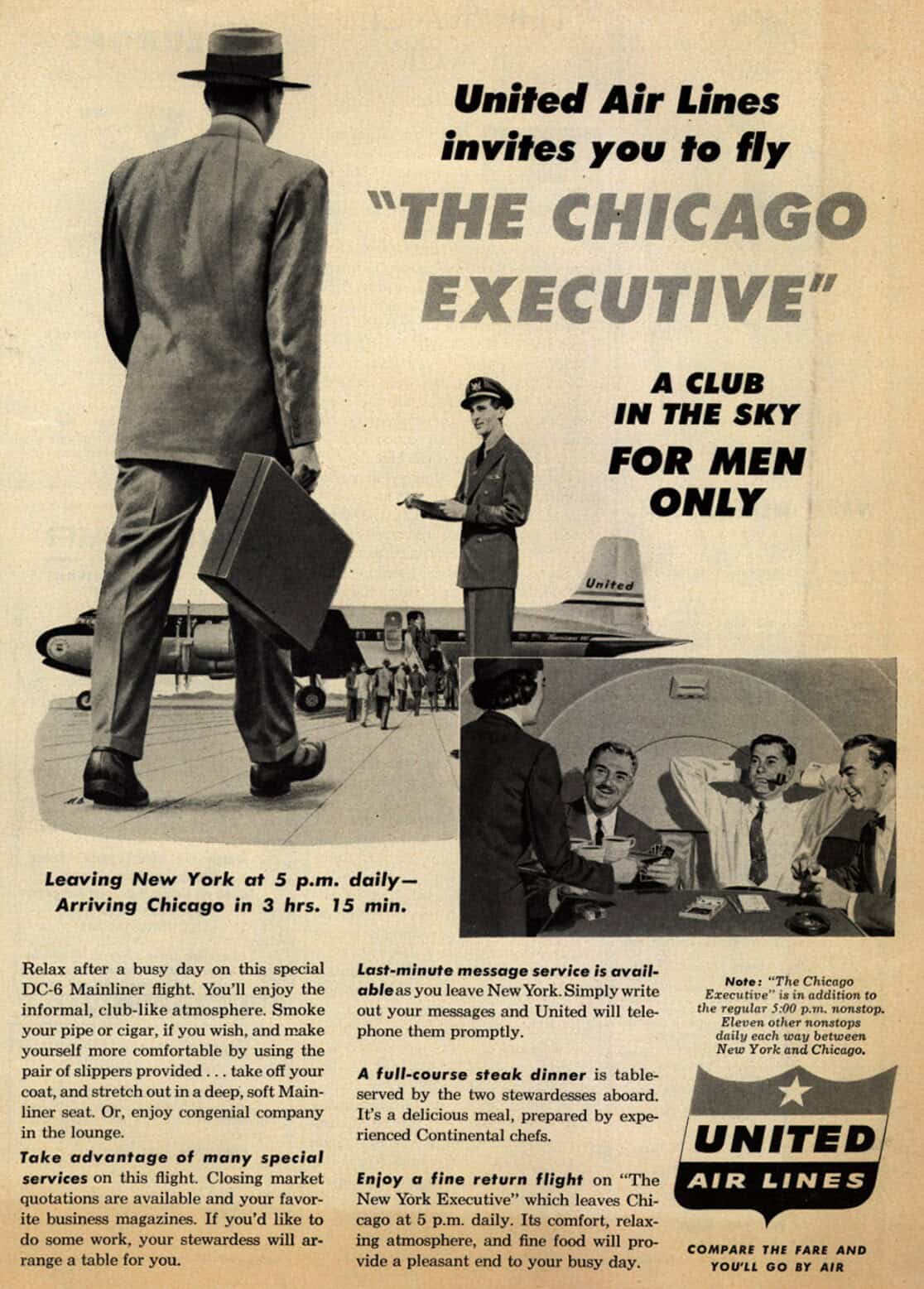
The Boys-Only Boarding Call
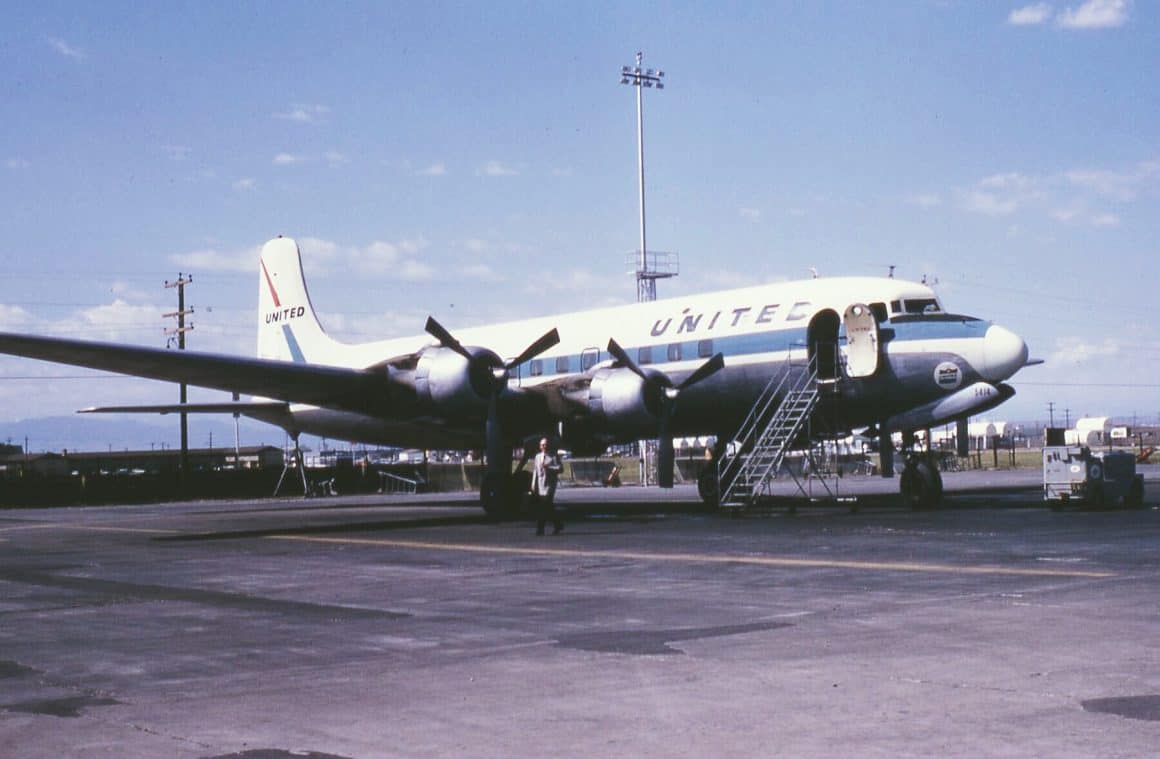
United’s men-only flights kicked off in 1953, operating between New York and Chicago—known as The New York Executive or The Chicago Executive, depending on which way you were headed. For the West Coast elite, they later added a Los Angeles-to-San Francisco route. Running once a day, six days a week (Sunday was apparently for family penance), the flight clocked in at a leisurely 3 hours and 15 minutes. The fare? A cool $67—$3 more than a standard first-class ticket, but oh, the perks made it worth every penny.
Flown initially on piston-powered Douglas DC-6Bs out of LaGuardia (LGA) to Chicago’s Midway (MDW), the service upgraded in 1961 to the sleek new French-made Sud Aviation Caravelle, an all-first-class jet with 64 seats. Extra runway requirements prompted a shift to New York Idlewild (later JFK) and Chicago O’Hare (ORD) before a final change to Newark (EWR) in the late ’60s.
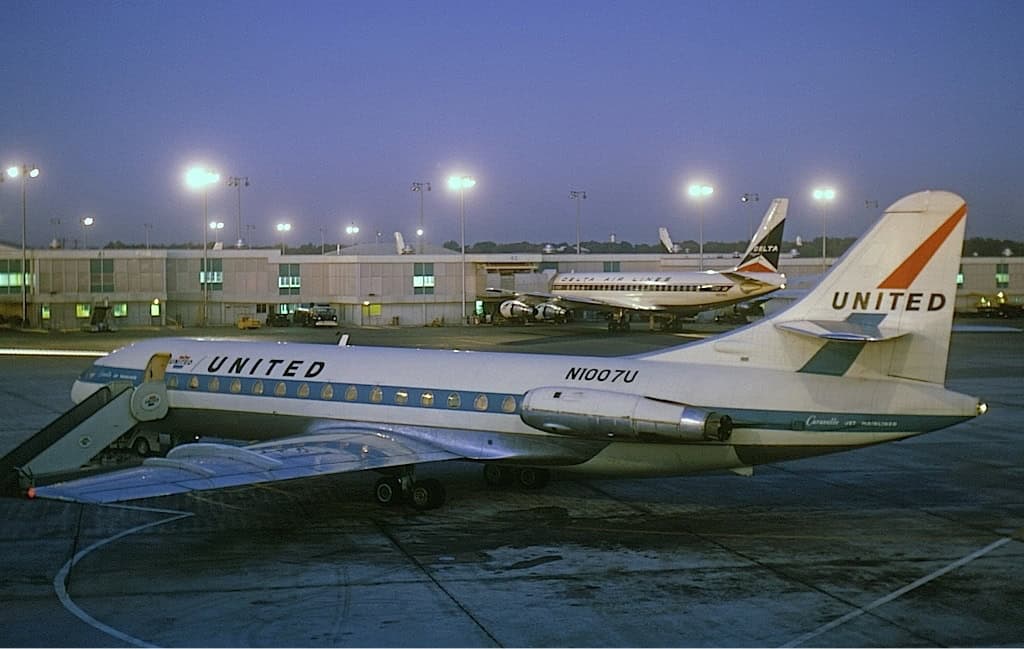
Women and children were strictly verboten—though, in a twist of irony, the stewardesses were all female, lighting cigars and pouring martinis with a smile.
What we give men is an opportunity to get away from women.
United spokesman, 1954
In March 1954, a United spokesman summed it up with a smirk: “What we give men is an opportunity to get away from women. We don’t regard it as segregation. We regard it rather as a little luxury.” Subtle, right?
Slippers, Cigars, and Steak: The Inflight Experience

If the Executive Flight was a club, it was one where the dress code was “relaxed misogyny.” Men were instructed to ditch their jackets and ties, slip into provided slippers, and light up a pipe or cigar—stewardesses were on hand with matches, naturally. Dinner was a full-course steak affair, served on real china with baked potato and green peas. A two-drink limit (gin martinis were the go-to) was technically in place, but those stewardesses had a notorious habit of “forgetting” to count.
The plane itself was a businessman’s dream: workspaces for the industrious (simply notify the stewardess, and she would prepare a table for you), live stock quotes via teletype (courtesy of the Wall Street Journal, a sponsor), and a lounge for “congenial company.” Need to dash off a last-minute message? United’s “last-minute message service” had you covered—scribble a note as you left New York or Chicago, and they’d phone it in for you. In its first year, 19,500 passengers boarded, proving that the allure of a kid-free, wife-free sky was strong.
And the cherry on top? A parting gift worth that extra $3: a glass ashtray with an airplane sketch and cufflinks—one with a built-in watch. Because nothing says “I’ve escaped my family” like a tiny wrist clock.
Meanwhile, Mohawk’s Gas Light Gambit

United wasn’t alone in this macho madness. In 1960, Mohawk Airlines rolled out the “Gas Light Service,” a Victorian-themed men-only flight inspired by old railroad cars. Operating two converted 28-seat DC-3s—decked out with red velvet curtains, lace headrests, gold tassels, carriage lamps, and vintage lithographs—it served routes like Buffalo (BUF) to Boston (BOS) via Rochester (ROC) and Syracuse (SYR). Later, they added Syracuse to Boston via Hartford-Springfield (BDL), Albany (ALB), and Utica-Rome (UCA), plus a weekend Newark-to-Ogdensburg (OGS) run via Watertown (ART).
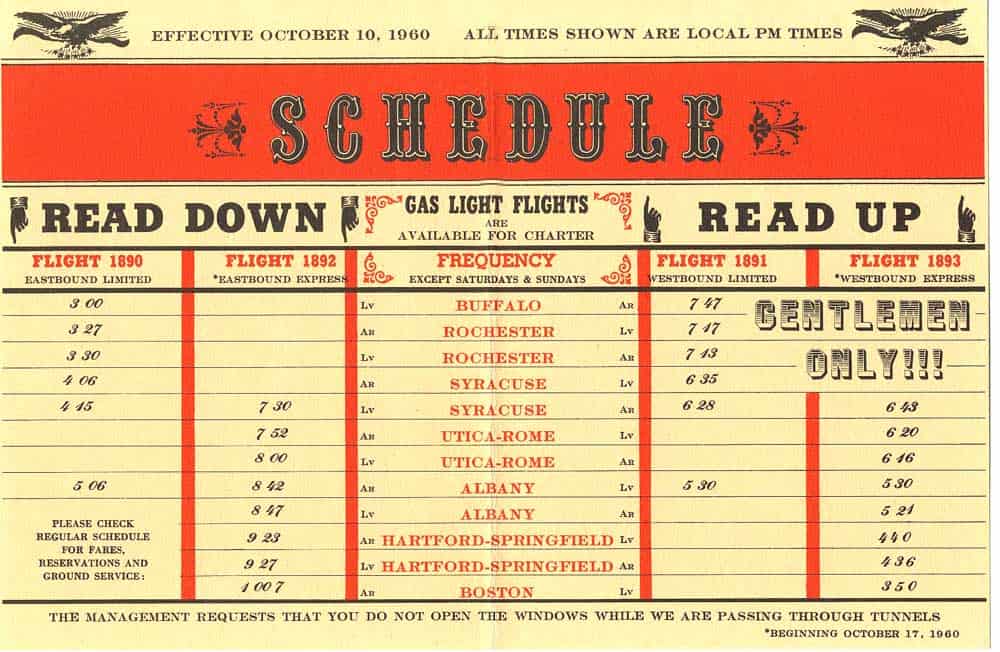
Mohawk’s pitch? Five-cent cigars, free beer, cheese, and pretzels in a “cloudy” atmosphere women would supposedly hate. (They reassured the public that ladies and kids were welcome on other flights.) Sequined, ostrich-feathered stewardesses in Gay Nineties garb kept the vibe lively. It was a smash—23,000 passengers, 31,700 beers, and 17,000 cigars in two years. So successful, in fact, that Mohawk opened the cabins to women and kids, relegating them to a “family parlor” up front while the boys kept the smoky man-cave in the back. The service even extended the DC-3s’ lifespan by a year before Mohawk finally retired the type in 1962.
The Beginning of the End
United’s men-only flights soared on, racking up 10,500 segments by 14 January 1970, when the final flight touched down. But the skies were changing. Once a robust 80-90% in 1953, load factors had slumped to around 40% by the late ’60s. The National Organization of Women (NOW) wasn’t amused, either— a 1969 protest at United’s Chicago HQ was widely seen as the death knell, though the airline coyly dodged blaming the feminists. Profitability, not picket signs, was the real killer.
The Executive Who Almost Crashed the Party
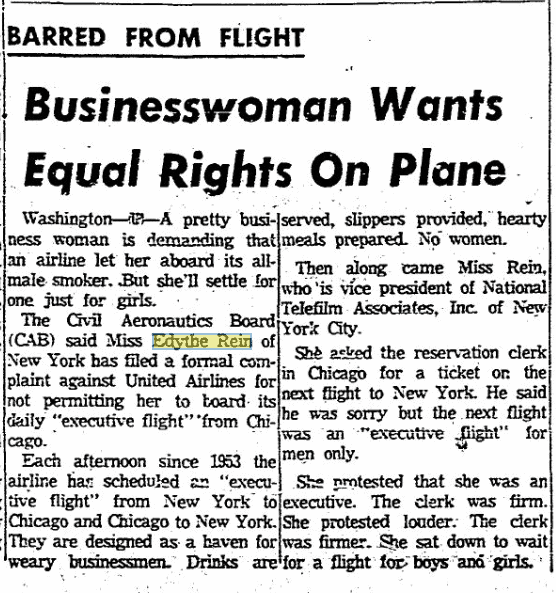
Passengers mourned the loss. “One of the nicer things in life is disappearing,” one told The New York Times on 16 January 1970. Another was blunter: “It’s not because of no women. It’s because there are no squealing kids.” Fair enough—priorities.
It’s not because of no women. It’s because there are no squealing kids.
A passenger explaining why he liked the Executive Flight service, 1970
Not everyone was content to watch the boys’ club fly by. In January 1958, Edythe Rudolph Rein, a VP at National Telefilm Associates, tried to book the next United flight from Chicago to New York. Told it was an Executive Flight, she protested, “I’m an executive!” The ticket agent didn’t budge. She sat down, fuming, and later filed a complaint with the Civil Aeronautics Board (CAB).
It didn’t topple the service, but it was a sign the times were—ahem—taking off in a new direction.
Legacy of United’s Men-Only Executive Flights
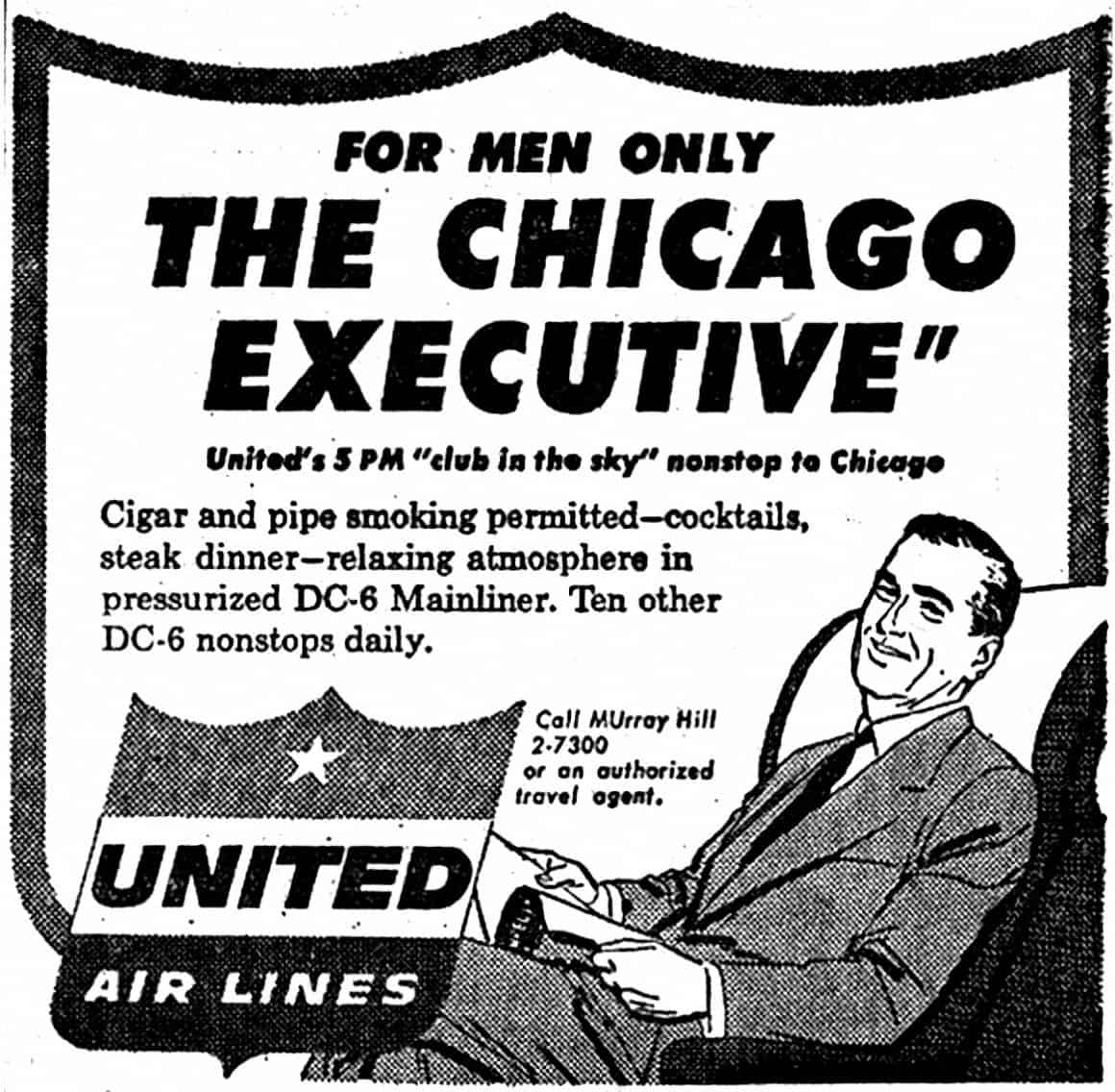
United’s men-only flights were a relic of an era when “luxury” meant cigars, steak, and a break from the fairer sex. For 17 years, they offered a mid-century fantasy of escape—until reality, and a few angry women brought it back to earth.
Today, we can only chuckle at the audacity of it all, light a metaphorical cigar, and toast to a time when aviation dared to be this unapologetically bonkers.
